North Dakota is currently experiencing an economic boom that is bringing prosperity to the state and many of its citizens. The prosperity is not shared by all, however. Many workers helping to generate the economic boom do not feel its benefit and nearly one third of North Dakota families struggle to make ends meet. Most of these families work. Fully 85 percent of North Dakota’s lowincome families have at least one working parent.
A good job is the route to economic security for many families. But what qualifies as a “good” job? A good job is one that pays more than the cost of basic expenses in the region; offers paid sick leave, retirement benefits and health insurance at a manageable cost; and, provides job security and opportunities for advancement. The jobs of low-income workers, almost by definition, do not meet these criteria. Concentrated in jobs and industries with low wages, few benefits, little security, and a scarcity of fulltime positions, low-income workers often struggle to afford basic necessities, much less get ahead. For many families in North Dakota and throughout the country, even full-time work does not provide adequate means.
Work supports can help close the gap between low wages and the cost of basic necessities. Earned income tax credits, child care subsidies, public health insurance and other work support programs help reduce costs and increase income for working families. Such programs have proven to be effective in lifting people above poverty and improving attachment to work and job security for low-wage earners.
Yet, despite the economic and social benefits of increasing income and supporting work, North Dakota’s programs for low-income families do not always reinforce advancement in the workforce or provide adequate resources for workers.
This brief uses the Family Resource Simulator and Basic Needs Budget Calculator, policy analysis tools developed by the National Center for Children in Poverty (NCCP) (see box), to demonstrate the basic costs associated with living and working in North Dakota and illustrate the important role of work supports in helping low-income families make ends meet. The brief also assesses the efficacy of North Dakota’s work support policies in helping families achieve economic security, with a focus on how a small adjustment to North Dakota Healthy Steps (State Children’s Health Insurance program or SCHIP) eligibility could positively impact the health and finances of working families.
The Family Resource Simulator and Basic Needs Budget Calculator: Tools for Policy Analysis
This brief features results from NCCP’s Family Resource Simulator and Basic Needs Budget Calculator, web-based policy analysis tools designed for policymakers, administrators, advocates, and researchers. The Family Resource Simulator calculates the impact of federal and state work supports on the budgets of low- to moderate-income families. The Simulator concretely illustrates the effectiveness of current policies in encouraging and supporting work. NCCP also uses this tool to model potential policy reform. Family Resource Simulators are available or under development for 24 states.
The Basic Needs Budget Calculator is a related tool that shows how much a family needs to make ends meet without the help of work supports. Users select the number of parents and ages of children and may adopt the expense estimates developed by NCCP or replace them with their own estimates. The Budget Calculator estimates the family’s tax liability and overall budget according to these entries.
In North Dakota, the Simulator and Budget Calculator are developed for Bowman County; Bismarck, Burleigh County; Fargo, Cass County; Grand Forks, Grand Forks County; Minot, Ward County, and Williams County. (Throughout the rest of the brief, if the county has a Metropolitan Statistical Area, or MSA, within it the MSA name is used. Otherwise, the county name is used.)
The Family Resource Simulator and Basic Needs Budget Calculator are available on NCCP’s website.
Working Families Struggle, Even in a Strong Economy
At a time when most states are experiencing slow or no growth and struggling to close major budget gaps, North Dakota is the only state in the nation to have not recorded a budget shortfall during the recession. To the contrary, the state ended 2010 with a significant budget surplus. The North Dakota Office of Management and Budget (OMB) forecasts continued growth, fueled by oil revenues and tax collections that continue to exceed expectation. Sustaining the lowest unemployment rate in the nation, at 3.8 percent in November 2010, North Dakota is one of only two states – Alaska is the other – to have created jobs during the Great Recession. North Dakota’s general prosperity is expected to continue, with increases in gross state product, total employment and personal income.
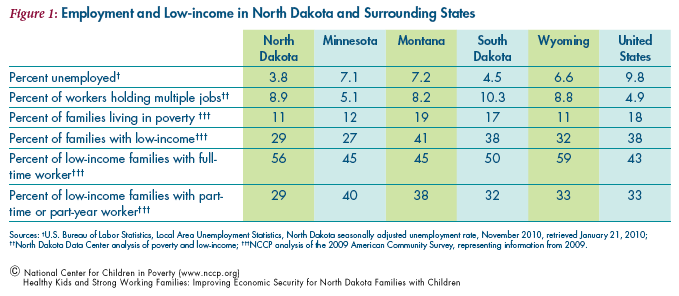
North Dakota’s working families should be thriving while the state experiences such low unemployment, strong job growth, and a robust economy. In fact, the strong state economy has not translated into economic security or better prospects for many North Dakota families. Rates of poverty and low income in North Dakota have changed little over the past 10 years and remain similar to other states in the region with less positive economic and employment outlooks. Even as the state has prospered, 11 percent of North Dakota’s families live with incomes below the poverty line and 29 percent have low income.
This is not good news for the state, as even short spells of poverty have negative effects on the health and well being of children and adults. Poverty, whenever it is experienced, is associated with worse outcomes for health and education, housing stability and employment prospects.
Work is the norm for families with low income in North Dakota and across the region. Eighty-five percent of low-income families with children in the state have at least one parent who works. Fifty-six percent of low-income families with children have a parent who works full-time. The high rate of work overall among low-income families, the high rate of full-time workers among families with low-income, and the high rate of multiple job holding signal the troubling prospect that while jobs are abundant in North Dakota, good jobs remain elusive for many in the state.
Basic Needs Are Out of Reach for Many
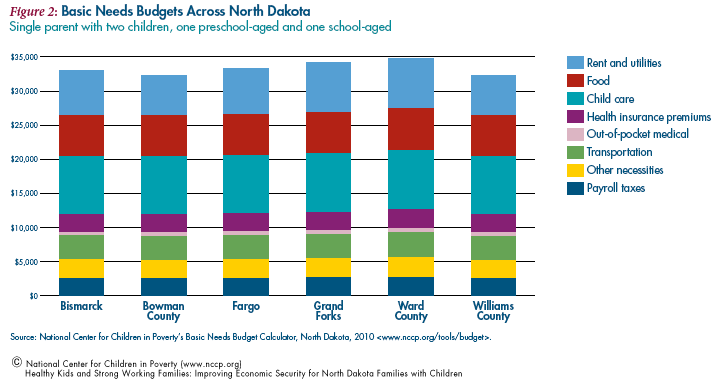
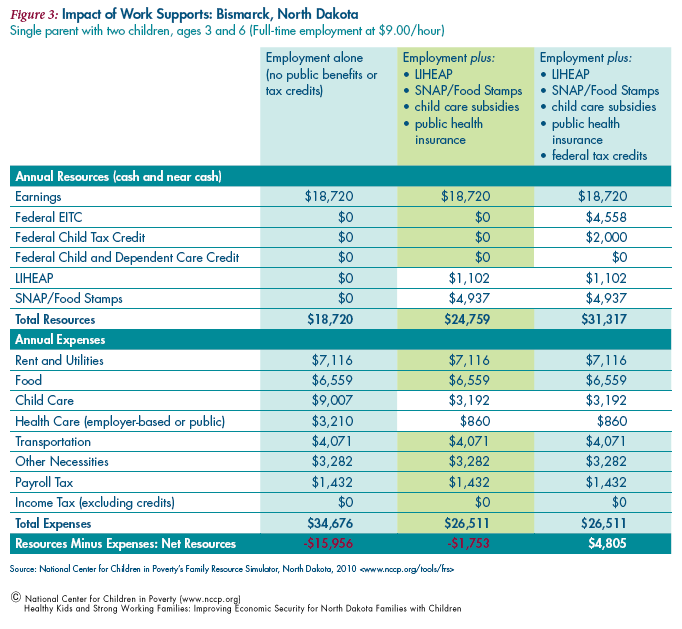
Across the six areas modeled (Bowman County, Bismarck, Fargo, Grand Forks, Ward County and Williams County) in the Basic Needs Budget Calculator for North Dakota, basic expenses in North Dakota far exceed the earnings of low-wage workers. A single parent with two young children must earn on average $15.85 per hour at full-time, year-round work to make ends meet – more than twice the minimum wage and double the $7.93 median wage for a cashier, one of the largest occupation categories in North Dakota.
NCCP models a “basic needs” budget of essential costs for working families, including housing and utilities, food, child care, health care, transportation, payroll and income taxes, and a small amount for additional necessities. The budget is set at a modest level that provides for safe and decent housing, adequate food, health insurance, and regulated child care but includes no “extras,” such as debt repayment, entertainment, or spending on education. There is also little to nothing left for families to save for the future.
While the costs in the Basic Needs Budget are set at a very modest level, the necessary wages are still out of reach for many working families in North Dakota. Work support programs can help add income or reduce expenses for families whose wages alone are not enough. Programs such as Supplemental Nutrition Assistance Program (SNAP; formerly called food stamps), subsidized child care, Medicaid, Healthy Steps and federal and state tax credits provide essential financial support to working families, helping them meet immediate expenses for child care, health care, housing , food, transportation and other necessities.
In Figure 3, a hypothetical worker’s full-time earnings put her slightly above the poverty level yet desperately far from being able to meet expenses on earnings alone. The column entitled “Employment Alone” illustrates the Basic Needs Budget for a single parent with two children, working full time for $9.00 per hour.
- Payroll taxes effectively reduce the family’s takehome pay to $8.31 per hour. At this low income, the family does not owe income taxes.
- The family’s biggest expense is child care. At $9,007 per year, it is 26 percent of the total costs and a full 50 percent of the family’s earnings.
- The cost of rent and utilities is 38 percent of income, above the level commonly considered a “rent burden.”
- Even with the employer-sponsored health insurance assumed here, health costs are 17 percent of the family’s income.
Without federal tax credits or other work supports, this family would face a deficit of $15,956 every year.
The “Employment plus” columns show the interaction of expenses and key work supports: SNAP, Low Income Heating Assistance Program (LIHEAP), Medicaid and Healthy Steps public health insurance, subsidized child care, and federal tax credits.
- With employment alone, the parent faces a shortfall of $15,956 between annual resources and expenses.
- With employment and the addition of multiple work supports including SNAP, LIHEAP, Healthy Steps for children, and child care subsidies, the family faces a much more manageable deficit of $1,753.
- With the addition of federal tax credits – EITC, Child and Dependent Care Credit and Child Tax Credit – the deficit of over $15,000 disappears and the family has a small surplus which can be used to pay off debt or save for future expenses.
Work Supports Help Families Make Ends Meet
The Basic Needs Budget assumes that families spend their scarce resources on health insurance and child care in addition to less mutable expenses, such as housing and transportation. Faced with a budget shortfall of the size seen in this example, however, it is more likely that the family would cut back on expenses – going without health care; using less expensive, unregulated child care; moving to substandard housing; cutting back on basic necessities like food – and still accrue debt.
Work supports can help mitigate such tough choices, affording families access to better housing and nutrition, higher quality child care and more regular health care, all of which improve the longterm health, education and economic outcomes of low-income children and families. Most work support programs are means-tested, meaning that eligibility and benefit amounts are tied to amount of income. For some programs, like SNAP, LIHEAP and the EITC, benefits phase out gradually as income increases toward the eligibility limit. In other programs, like health insurance and child care, high-value benefits come to a sudden end when the eligibility limit is reached.
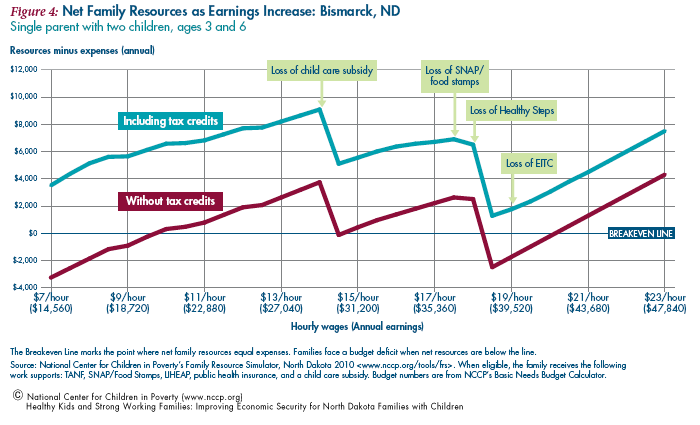
Figure 4 illustrates the interaction of North Dakota’s work support programs at different earning levels and highlights the impact of tax credits targeted to low- and moderate-income families. The pattern of the graph illustrates how and where a small increase in earnings can lead to a large loss in resources, a “cliff ” that leaves families worse off after a small pay raise or increase in work hours.
The two lines, “Without Tax Credits” and “Including Tax Credits” show the same basic pattern of slowly rising resources and sudden cliffs as earnings increase. Regardless of income, without the value of tax credits a single parent with two children is never far from a budget deficit. In this example, the family experiences two large cliffs at different income levels.
- At about $14.00 per hour, if the family achieves a small pay raise of $1.50 per hour, it loses eligibility for subsidized child care. Center-based unsubsidized care more than doubles the family’s child care cost, adding a $4,626 per year expense that outweighs the earnings increase of $3,120 minus taxes.
- Between $17.50 and $18.50 per hour, a small increase in earnings leads to loss of the federal EITC and Healthy Steps, North Dakota’s public health insurance program for children. Losing these resources costs the family much more than the $2,080 in annual income it gains from the one dollar pay raise.
- If the family must pay for private health insurance to keep the children covered, the cost of losing Healthy Steps and replacing it with private family insurance is $6,000 per year. If the family had access to employer-sponsored health insurance, the combined cost to the family in losing Healthy Steps is $3,210.
Federal tax credits are an important part of a low income working family’s budget, supplementing household resources, offsetting resource cliffs occasioned by the loss of other work supports, and reducing the annual earnings required to meet basic expenses. Many families may find it difficult to save tax credits to pay future expenses or build assets. As illustrated in Figure 4, families with resources below or slightly above the breakeven line are likely to need the tax credits to pay back debt incurred between tax refunds or plan to use the refund for a major necessary expense, such as a car or home repair or medical procedure.
The circumstance modeled here must be viewed as a best-case scenario, with the family receiving all available benefits. In practice, few families receive all of the benefits for which they are eligible. The barriers in applying for and continuing to access programs are many.
- Families may not know they are eligible to participate in work support programs or may avoid applying because of the stigma attached to receiving benefits.
- Application and recertification processes are often lengthy, complicated and numerous. Some services for which families are eligible may be impossible to access if, for example, there are no convenient child care or health care providers who accept the subsidy.
- Even when families are able to enroll, they face the problem of a disconnected set of programs that do not always work together to ensure adequate resources or reward progress in the work force.
A work support system that works to help families achieve economic security and increased opportunity would provide adequate family resources when they are needed and always reward workforce advancement, rather than penalizing it. Barriers to access and steep resource “cliffs” make state programs less effective both at preventing poverty and supporting work.
North Dakota Can Improve the Health and Security of Low-Income Families
North Dakota can improve work attachment and economic security for low-income families by further eliminating application barriers, expanding eligibility, and setting income limits that are related to the financial circumstances of low-income families. North Dakota’s work support programs already utilize several policy options that are good for working families: Healthy Steps allows income deductions for child care and health care expenses; Medicaid and Healthy Steps have continuous eligibility for 12 months before recertification is required; SNAP uses expanded eligibility criteria; and, although asset tests limit eligibility to some programs, the system as a whole makes limited use of them.
North Dakota could build on these policies by increasing access to public health insurance. While the state’s overall rate of un-insurance is lower than many others, North Dakota has a comparatively poor record of providing health insurance to its low-income citizens.
- At 74.6 percent of all eligible people, North Dakota’s enrollment in Medicaid and State Child Health Insurance (SCHIP; called Healthy Steps in North Dakota) is the eighth lowest in the nation.
- The state Medicaid limit for adults is so low (34 percent FPL) that the program is effectively closed to working parents and North Dakota offers no state health insurance option for parents.
- North Dakota is one of only four states to set eligibility for SCHIP (Healthy Steps) below 200 percent FPL.
Expanding Healthy Steps eligibility from its current limit of 160 percent FPL to families earning 200 percent FPL would bring North Dakota’s children’s health insurance policies in line with other states while addressing a significant barrier to the health and economic security of low-income families.
Lack of health insurance has negative consequences for access to health care and health outcomes that are long lasting. Lack of health insurance is associated with lack of a medical “home,” leading to irregular and inconsistent care. A health insurance gap of only a few months can lead to less preventive care in the present and inconsistent health care in the future. Lack of health insurance also has significant impact on a family’s finances, as the uninsured tend to pay more than the insured for health services and face the risk of high medical debt that they will have trouble paying down. At low incomes, the cost of health insurance must be balanced against other essential costs such as housing, child care and food. If other costs are not negotiable, health insurance may become an unaffordable “luxury.”
Affordable health insurance is out of reach for the many low-income workers in North Dakota who do not have access to employer-sponsored health insurance. Full-time low-income workers are much less likely than their non-low-income peers to have private health insurance and more likely to be uninsured. North Dakota’s retail and service industries comprise one of the largest employment sectors in the state and have a concentration of low-wage employees; fewer than half of the employers in these industries offer health insurance benefits. In general, the more part-time or low-wage workers firms employ, the less likely they are to offer health insurance benefits to their employees. Part-time workers in North Dakota are especially unlikely to be eligible for employer-sponsored health insurance; only 29.1 percent of part-time workers across industries and 12.8 percent of part-time retail and sales workers are eligible for employer-sponsored health insurance.
Even when workers have access to employer-sponsored health insurance, they may have difficulty affording it. Across industries in North Dakota, only 61.2 percent of workers with access to employer-sponsored health insurance are enrolled. The percentage is much lower for retail and other service employees, of whom only 38.5 percent with access to employer-sponsored health insurance are enrolled.
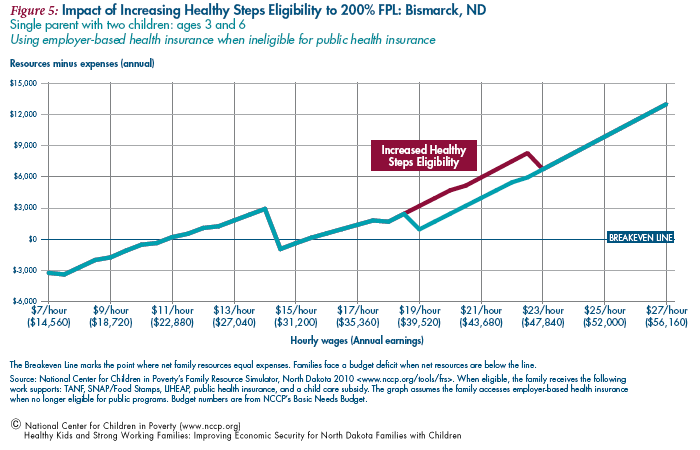
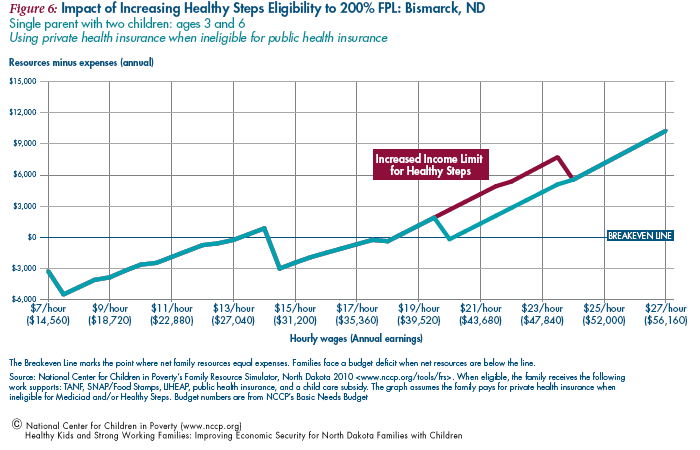
Figures 5 and 6 illustrate how the state’s austere limits on public health insurance eligibility for adults and children leave many low-income families without an affordable health insurance option. In this example of a single parent with two children, the parent loses Medicaid eligibility at about $15,000 per year, less than minimum wage and well below the poverty line for a family of three. The children are eligible for Healthy Steps up to 160 percent FPL. Yet even at this level, the loss of Healthy Steps creates a resource cliff at an income where many families will not have additional resources to put toward health insurance. By extending eligibility to 200 percent FPL, the resource cliff is shifted to a higher income level – from about $39,000 to $47,000 annually – at which point more families will have the means to absorb the additional cost of private or employer-sponsored health insurance without falling into debt.
Figure 5 models the change in net resources when the family has access to employer-based health insurance – at a cost of $860 per year for the parent alone and $3,210 per year for the family – when public health insurance eligibility ends. In this scenario, the family would be better off with public health insurance but could manage the cost of the employer plan modeled here, with careful budgeting.
Figure 6 models the same situation, but assumes that the family does not have access to an employerbased plan and must buy private health insurance, which is significantly more expensive – at $3,004 for the parent alone and $5,967 for the family. More than triple the cost of employer-based insurance for the parent and nearly double the cost for the family, private health insurance would still be prohibitive for this family at the current eligibility limit of 160 percent FPL.
An income limit of 200 percent FPL would extend eligibility for Healthy Steps to the majority of uninsured children in North Dakota, of which 59 percent were living in low-income families in 2006. With a strong economy and budget, North Dakota policymakers are well positioned to bring their state’s health insurance programs in line with other states, improving the health and economic security of the state’s low-income children and families.
Results from the Family Resource Simulator and the analysis in this briefing paper cannot be generalized to Native Americans living or working on tribal lands, except where indicated in the brief.
As sovereign nations, tribal governments may institute different public benefit and work support programs and establish different eligibility rules, benefit levels, and services than states and the United States federal government. Tribal members are in a different relationship to state and federal governments than other United States citizens, further impacting how eligibility is determined for programs and taxes modeled by the Family Resource Simulator. Currently, the Family Resource Simulator can neither accommodate these differences nor apply different income and resource rules for Native American applicants to the general state and federal programs. Further research is also needed to determine if the national data sources used to establish costs in the Basic Needs Budget Calculator are representative of costs in tribal lands. For these reasons, the results from NCCP’s tools cannot be extended to Native American tribal members.
NCCP recognizes that this is a significant gap in the analysis of income and work support policy, especially in states with a large Native American presence. Throughout the United States, Native Americans suffer significantly higher rates of poverty and unemployment than the statewide averages. This is true also for North Dakota, where residents of counties encompassing tribal lands are nearly three times as likely to be living in poverty as the state average and have a median income roughly half the statewide median income.
Further research and modeling of work support programs run by tribal governments on tribal lands could help tribal leaders, community members and policymakers understand what programs are available to Native American families and children, the relationship among programs, and their impact in alleviating poverty and need.
Endnotes
1. McNichol, E.; Oliff, P.; Johnson, N. Dec. 16, 2010. States Continue to Feel Recession’s Impact. Center on Budget and Policy Priorities.
2. North Dakota Office of Management and Budget. Nov. 2010. Rev-E-News, Message from the Director.
3. “Poor” is used to indicate a family with income below 100 percent of the Federal Poverty Level, or FPL, or $18,310 for a family of three in 2010. “Low income” is the common designation for those with income below 200 percent FPL, or $36,620 for a family of three in 2010.
4. U.S. Bureau of Labor Statistics, State Occupational and Employment Statistics, Hourly Median Wage for All Occupations. May 2009.
5. Health Affairs. October 2010. Who and Where are the Children Yet to Enroll in Medicaid and the Children’s Health Insurance Program?
6. Heberlein, M.; Brooks, T.; Guyer, J. Georgetown University Center for Children and Families and Artiga, S.; Stephens, J. Kaiser Commission on Medicaid and the Uninsured. Jan. 2011. Holding Steady, Looking Ahead: Annual Findings of a 50-state Survey of Eligibility Rules, Enrollment and Renewal Procedures, and Cost Sharing Practices in Medicaid and CHIP, 2010-2011.
7. Sell, K.; Zlotnik, S.; Noonan, K.; Rubin, D. Nov. 2010. The Effects of Recession on Child Well Being. Policy Lab, Research Institute of the Children’s Hospital of Philadelphia.
8. Agency for Healthcare Research and Quality, Center for Financing, Access and Cost Trends. 2009 Medical Expenditure Panel Data.
9. Compensation for Workers With and Without Access to Benefits at Work. Oct. 2008. Kaiser Family Foundation.
10. Agency for Healthcare Research and Quality, Center for Financing, Access and Cost Trends. 2009 Medical Expenditure Panel Data.
11. North Dakota KidsCount. 2010 Fact Book: State, Regional and County profiles of Child Well Being in North Dakota. Accessed from www.ndkidscount.org, Dec. 2010.
